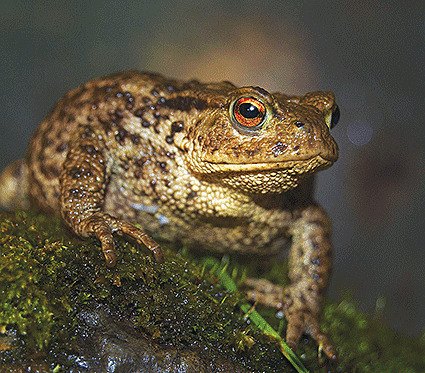Sussex Wildlife Trust: The Eye of the beholder
February 9th, 2020 Toads are beautiful. Yes, I know they have lumpy, poisonous skin. Yes, I know they have a face like Ena Sharples. But that eye. That amazing eye.
Toads are beautiful. Yes, I know they have lumpy, poisonous skin. Yes, I know they have a face like Ena Sharples. But that eye. That amazing eye.Ensconced in my corner of a Sussex pub I didn’t look far for inspiration for this month’s article. The clanging of brass on lead alerted me to a couple of lads playing that most Sussex of pub games – Toad in the Hole. The perfect excuse for some sycophantic toadying to an amphibian I adore; warts and all.
Toads are beautiful. Yes, I know they have lumpy, poisonous skin. Yes, I know they have a face like Ena Sharples. But that eye. That amazing eye. Next time you see a toad get right up close and allow yourself to be hypnotized by that mesmerizing golden-ringed eye. Fellow toad lover George Orwell called it 'about the most beautiful eye of any living creature'.
In February that beautiful eye blinks open as toads awaken from their winter hibernation. From under stones, logs and leaves they emerge and start the long walk home – back to the pond where they were born. They proceed on this pilgrimage with a determined, unsteady gait – like one of those old men you see gingerly crossing the shingle on his way to his annual New Year’s Day dip. But once the Toad hits the water he is rejuvenated and has one thing on his mind. Croaking and brawling, a peaceful pond is transformed into a Club 18-30 pool party as male Toads squabble over females in a writhing ball of amorous amphibians.
The results of this Bacchanalian bonding are long polka dot ribbons of spawn (unlike the Frog’s shapeless tapioca blobs) and by May the parent Toads have left their breeding ponds to lead a more respectable life on dry land until their winter hibernation. Amazingly these animals can live for over 40 years.
With their primordial appearance, annual gatherings and rituals there is a touch of evil about the Toad. Throughout England’s history they have been vilified; linked to witchcraft and strange superstitions. And, when it comes to folklore, there’s nowt so queer as Toads. Rubbing Toads on your body could cure cancer; a live Toad in your mouth could cure skin infections. Precious jewels (toadstones) were reputed to be hidden in a Toad’s head. Immortal toad-eaters were a sideshow attraction at country fairs. Travelling Toad doctors could heal you with Toad hearts and legs. The mysterious Toadmen used Toad potions to cure horses (a practice that allegedly continued until the 1930s in some English counties)
It took Kenneth Grahame’s beloved ‘The Wind in the Willows’ to finally drag the Toad out of the dark ages putting him in a tweed suit and in the hearts of the nation. Keep an eye out for these amazing animals around Sussex in the coming months as they return to their ponds.
By Michael Blencowe: Learning & Engagement Officer, Sussex Wildlife Trust.
Sussex Wildlife Trust is an independent registered charity caring for wildlife and habitats throughout Sussex. Founded in 1961, we rely on the support of our members to help protect our rich natural heritage. Please consider supporting our work. As a member you will be invited to join Michael Blencowe on our regular wildlife walks and also enjoy free events, discounts on wildlife courses, Wildlife magazine and our guide book, Discovering Wildlife in Sussex. It’s easy to join online at: www.sussexwildlifetrust.org.uk/join or T: 01273 497532.
toad©Alan Price Gatehouse Studio Sussex Wildlife Trust.
Toads are beautiful. Yes, I know they have lumpy, poisonous skin. Yes, I know they have a face like Ena Sharples. But that eye. That amazing eye. Next time you see a toad get right up close and allow yourself to be hypnotized by that mesmerizing golden-ringed eye. Fellow toad lover George Orwell called it 'about the most beautiful eye of any living creature'.
In February that beautiful eye blinks open as toads awaken from their winter hibernation. From under stones, logs and leaves they emerge and start the long walk home – back to the pond where they were born. They proceed on this pilgrimage with a determined, unsteady gait – like one of those old men you see gingerly crossing the shingle on his way to his annual New Year’s Day dip. But once the Toad hits the water he is rejuvenated and has one thing on his mind. Croaking and brawling, a peaceful pond is transformed into a Club 18-30 pool party as male Toads squabble over females in a writhing ball of amorous amphibians.
The results of this Bacchanalian bonding are long polka dot ribbons of spawn (unlike the Frog’s shapeless tapioca blobs) and by May the parent Toads have left their breeding ponds to lead a more respectable life on dry land until their winter hibernation. Amazingly these animals can live for over 40 years.
With their primordial appearance, annual gatherings and rituals there is a touch of evil about the Toad. Throughout England’s history they have been vilified; linked to witchcraft and strange superstitions. And, when it comes to folklore, there’s nowt so queer as Toads. Rubbing Toads on your body could cure cancer; a live Toad in your mouth could cure skin infections. Precious jewels (toadstones) were reputed to be hidden in a Toad’s head. Immortal toad-eaters were a sideshow attraction at country fairs. Travelling Toad doctors could heal you with Toad hearts and legs. The mysterious Toadmen used Toad potions to cure horses (a practice that allegedly continued until the 1930s in some English counties)
It took Kenneth Grahame’s beloved ‘The Wind in the Willows’ to finally drag the Toad out of the dark ages putting him in a tweed suit and in the hearts of the nation. Keep an eye out for these amazing animals around Sussex in the coming months as they return to their ponds.
By Michael Blencowe: Learning & Engagement Officer, Sussex Wildlife Trust.
Sussex Wildlife Trust is an independent registered charity caring for wildlife and habitats throughout Sussex. Founded in 1961, we rely on the support of our members to help protect our rich natural heritage. Please consider supporting our work. As a member you will be invited to join Michael Blencowe on our regular wildlife walks and also enjoy free events, discounts on wildlife courses, Wildlife magazine and our guide book, Discovering Wildlife in Sussex. It’s easy to join online at: www.sussexwildlifetrust.org.uk/join or T: 01273 497532.
toad©Alan Price Gatehouse Studio Sussex Wildlife Trust.
Comments (0)
No comments have been submitted yet.Why not be the first to send us your thoughts
Leave A Comment
Thank you for your comments, they will appear shortly once approved.
Recent Posts
Have You Seen...






